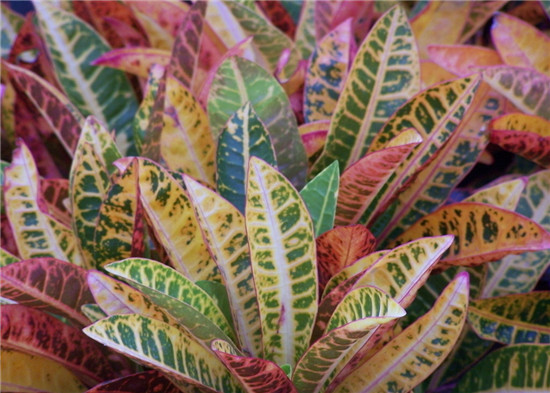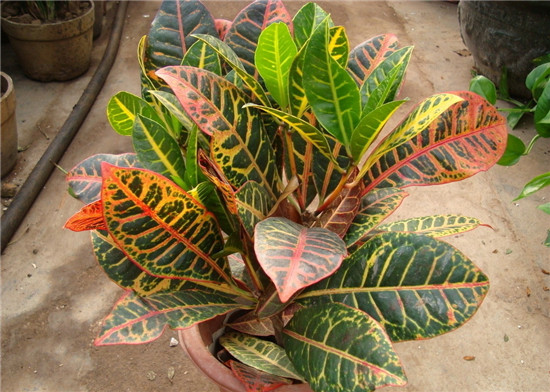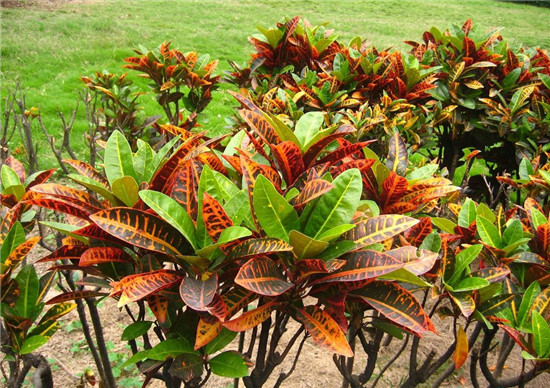Propagation methods of variable-leaf trees Culture skills of variable-leaf trees
Variable-leaf wood, also known as discolored laurel, can often be seen in tropical shrubs, native to Malaysia and the Pacific. Let's take a look at the reproduction of variable-leaf trees.

Leaf-changing wood is also known as discolored laurel. Euphorbiaceae, shrubs or small trees. The leaves are leathery, brightly colored and bright. Often potted, shrubs in the tropics. The leaves contain anthocyanins, monochromatic or green, yellow, white, orange, pink, red, scarlet and purple. The leaves are 10-15 cm (4-6 inches) long and vary in shape from variety to breed. They are slender, linear, lanceolate, ovate or parted. Its leaf colors are bright green, white, gray, red, light red, crimson, purple, yellow, yellowish red and so on.
Variable leaf wood 5-30 cm long, 0.5-8 cm wide, apex mucronate, acuminate to round-obtuse, base cuneate, mucronate to obtuse, margin entire, lobed to parted, both surfaces glabrous, green, light green, fuchsia, purplish red and yellow alternating, yellow and green alternating or sometimes scattered yellow or golden spots or markings on green leaves; petiole 0.2-2.5 m long. The leaf tree likes to be wet and afraid of dry. During the growing period, the stems and leaves grow rapidly, give sufficient water, and spray water to the leaves every day. However, the basin soil should be kept slightly dry at low temperatures in winter. Such as winter semi-dormant state, too much water, will cause fallen leaves, must be strictly controlled.

Euphorbia angustifolia is native to Java, Indonesia and Australia. Like high temperature, moist and sunny environment, not cold-resistant. The suitable temperature for the growth of variable-leaf wood is 20-30 ℃ and 21-30 ℃ from March to October. The winter temperature is not lower than 13 ℃. Short-term at 10 ℃, the leaf color is not bright, appear dim, lack of luster. When the temperature is 4-5 ℃, the leaves are damaged by freezing, resulting in a large number of fallen leaves, and even the whole plant freezes to death. Leaf-changing wood is a light-loving plant, which needs plenty of sunlight throughout the growing period, with luxuriant stems and leaves, bright leaves, especially red markings, more bright red.
Culture methods of variable-leaf wood
1. Soil: Euphorbia alternata prefers fertile, moist and well drained soil. 3 parts of garden soil, 1 part of compost, 1 part of river sand, or 3 parts of coarse peat, 3 parts of rotten leaf soil and 2 parts of sand could be used as substrates for pot cultivation.

2. Sunlight: the variable-leaf wood has a wide range of adaptation to light, but sufficient sunlight is beneficial to promote its good growth and obtain higher ornamental value. therefore, except for proper shading under strong summer light, the color of leaves becomes more beautiful in spring, summer and autumn under open-air light conditions. Leafy wood is not very shady, it is generally suitable to be placed indoors with strong astigmatism, and the time should not exceed 2-3 weeks. If long-term lack of light or lack of light, will make the leaf color lack of luster, but also easy to fall leaves.
3. Watering: during the growing period from May to October, the leaves should be given enough water and sprayed to the leaves and the ground every day to maintain high air humidity and smooth leaves. Gradually reduce the amount of water in late autumn and winter, but pay attention to spraying water to the leaves to keep the indoor air moist and properly ventilated.
4. Temperature: variable leaf trees like heat and fear cold, and the safe overwintering temperature in winter is 10-15 ℃. Defoliation is easy to occur when the temperature is lower than 10 ℃, and waterlogging or discoloration will also occur on the branches. It can adapt to high temperature above 30 ℃ in summer.
5. Fertilization: the rotten liquid fertilizer is generally applied to the variable leaf wood every two weeks. Nitrogen fertilizer should not be too much, otherwise the leaves will become green, dim and not gorgeous. From late autumn to winter, apply little or no fertilizer to avoid growing new shoots.

6. pest control: if the cultivation environment is high-temperature and dry, shellfish, red spiders and aphids are prone to damage. Red spiders and aphids can be sprayed with dimethoate 1000 times, shell insects can be sprayed with petroleum emulsion 100,150 times, and if soot occurs, scrub with clean water or spray carbendazim 1000 times.
The role of variable-leaf wood in the center of the home
Euphorbia angustifolia has medicinal value at home, including clearing heat and regulating lung, dispersing blood stasis and detumescence. It is used for lung qi inversion, carbuncle, sore and venomous snake bite.
Variable-leaf wood is very popular among foliage plants because it shows beautiful color and posture in its leaf shape and color, and it is mostly used in green space and garden beautification, and its branches and leaves are ideal leaf materials for flower arrangement. Variable-leaf wood is a kind of foliage tree with the most changes in color and shape in nature, which is extremely beautiful. Medium-sized potted plants are displayed in halls, conference halls and hotel restaurants to add a luxurious style; small potted plants can also be placed on the desk and coffee table in the bedroom and study, with exotic customs.
People are amazed by the peculiar change of leaf shape and colorful leaf color. Potted plants use it to put the corridor and balcony at home, which can show the elegant and luxurious style. Several pots adorn the living room and small garden, showing a scene of prosperity. Because it is not very shady, the viewing time indoors should not exceed 2-3 weeks. In the south, it is also suitable for courtyard layout, and its leaves are excellent decorative materials for wreaths, baskets and flower arrangements. Potted variable-leaf wood is insensitive to ethylene during storage and transportation, and can endure darkness for 30 days at 16-18 ℃ temperature and 80% Murray 90% relative humidity.
The above is the whole content of the breeding methods and breeding skills of variable-leaf trees that I have summarized for you. I hope this article can help you all. Please continue to follow us.
It can show the elegant and luxurious style. Several pots adorn the living room and small garden, showing a scene of prosperity. Because it is not very shady, the viewing time indoors should not exceed 2-3 weeks. In the south, it is also suitable for courtyard layout, and its leaves are excellent decorative materials for wreaths, baskets and flower arrangements. Potted variable-leaf wood is insensitive to ethylene during storage and transportation, and can endure darkness for 30 days at 16-18 ℃ temperature and 80% Murray 90% relative humidity.
The above is the whole content of the breeding methods and breeding skills of variable-leaf trees that I have summarized for you. I hope this article can help you all. Please continue to follow us.
- Prev

How to raise Hulk how to raise Hulk
How to raise Hulk how to raise Hulk
- Next

The difference between Scutellaria barbata and Hedyotis diffusa the characteristics of Scutellaria barbata and Hedyotis diffusa
The difference between Scutellaria barbata and Hedyotis diffusa the characteristics of Scutellaria barbata and Hedyotis diffusa
Related
- Wuhan Hospital Iron Tree Blooming Result Was Instantly Frightened by the Gardener Master
- Which variety of camellia is the most fragrant and best? Which one do you like best?
- What is the small blue coat, the breeding methods and matters needing attention of the succulent plant
- Dormancy time and maintenance management of succulent plants during dormancy
- Minas succulent how to raise, Minas succulent plant pictures
- What are the varieties of winter succulent plants
- How to raise succulent plants in twelve rolls? let's take a look at some experience of breeding twelve rolls.
- Attention should be paid to water control for succulent plants during dormant period (winter and summer)
- Watering experience of twelve rolls of succulent plants
- Techniques for fertilizing succulent plants. An article will let you know how to fertilize succulent plants.

